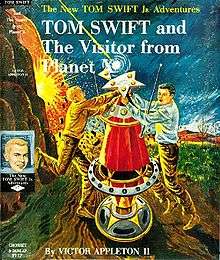Ginny Gordon
Ginny Gordon is the central character in a series of mystery books for adolescent girls published by the Whitman Publishing Company, a subsidiary of Western Publishing of Racine, Wisconsin, in the 1950s. The books were written by Julie Campbell Tatham, writing as Julie Campbell; she also wrote the original volumes of the Trixie Belden series (beginning in 1948) for Whitman.[1]
The Ginny Gordon series is very similar to the Trixie Belden books—apparently Whitman wanted a second series to appeal to the same audience as the first. In many ways, the Ginny Gordon books can be seen as less-well developed versions of the Trixie Belden series, but the books still have a good bit of charm in their depictions of youth culture of post-World War II, but still pre-Baby Boom, young teenagers.
Characters
Similar to Trixie, Ginny is fourteen years old and lives in Westchester County, New York. While Trixie is a farm girl, living two miles outside the small town of Sleepside, Ginny lives in Harristown, a suburb of New York City, but one that is still a small town with surrounding farmland. Her father is the publisher of the local newspaper.
The initial volumes of the Trixie Belden series provide a developing story arc (in the first book, Trixie Belden has no close friends, but meets new-girl-in-town Honey Wheeler, and they both meet Jim Frayne, a runaway; in the second book, Trixie and Honey trace Jim, who has run to upstate New York looking for a job at a boys' summer camp; in the third book, Trixie, Honey, and Jim are all safely at home—Honey's parents have adopted Jim—when Trixie's brothers Brian and Mart come home from camp; the five young people decide to start a secret club). The Ginny Gordon, books, though, begin in medias res, beginning in the fall of the year after school has started. Ginny's best friend is Lucy Tryon, who, like Honey Wheeler, was a new girl in town, but her arrival took place before the first book opened. At some date before the opening of the series, Ginny, Lucy, and John Blaketon—Ginny's love interest—and his thirteen-year-old twin cousins Whiz and Babs Reilly formed a secret club, the Hustlers. Like Trixie, Ginny loves a mystery, although Lucy is a much more reluctant partner than Honey Wheeler. John Blaketon stands in for both Jim Frayne and Brian Belden, as the older (at fifteen), more mature, and cautious voice of reason, trying to keep Ginny out of trouble. Whiz Reilly is very similar to Mart Belden, mostly making fun of Ginny.
List of titles
- Ginny Gordon and the Mystery of the Disappearing Candlesticks (1948). The Hustlers start a swap shop as a money-making project, but have to deal with the disappearance of Ginny's Great-Aunt Betsy's heirloom silver candlesticks, and along the way tackle a jewel thief.
- Ginny Gordon and the Missing Heirloom (1950). The Hustlers still have the swap shop, but now it is old Mrs. Arnold's pin[2] that is missing. Ginny finds that the plot is not just about a pin, but a scheming woman's plan to take over all of Mrs. Arnold's estate.[3]
- Ginny Gordon and the Mystery of the Old Barn (1951). The Hustlers have sold the swap shop to Joe Dakor, and their new project is a snack barn as a hangout for young people. The plot here, dealing with two criminals who had a falling out, is similar to the third Trixie Belden book, The Gatehouse Mystery. Here, though, it is not a diamond, but cash money that is left behind. One sub-plot deals with the arrival of "Lochinvar," a "hillbilly" (not yet rock and roll or country and western) singer who performs at the Harristown Inn (drawing the teen-aged crowd away from the Hustlers' snack barn).
- Ginny Gordon and the Lending Library (1954). The Hustlers latest project is a subscription lending library. Mystery develops as someone keeps trying to steal a popular novel.
- Ginny Gordon and the Broadcast Mystery (1956). There are several plots in this, but no real criminal activity. The Hustlers are having a used book sale at their lending library when a rare and valuable book of Mrs. Arnold's is mistakenly donated. When Mrs. Arnold attempts to recover the book, all the Hustlers are certain they did not sell it, but it cannot be found. Ginny tries to solve the mystery of the missing book, while other mysteries abound: the identity of a bitter young woman who moves to Harristown, all the pranks and confusion at the lending library. The whole time, Ginny is trying to organize a radio book-chat for teenagers that the local radio station asks her to do. A subplot deals with a popular novel, "My Heart's in the City," that everyone is sure is a roman a clef based on their own Harristown. This is perhaps based on the real furor that followed the publication of Peyton Place, which many people in New England felt was based on a real town.
Book formats
The Missing Heirloom, The Disappearing Candlesticks, and The Mystery of the Old Barn were published in hardcover with dustjackets, illustrated by Margaret Jervis. Whitman changed formats for their juvenile line by the time The Lending Library and The Broadcast Mystery were published in the mid-1950s. Rather than having illustrated dustjackets over solid-color hardcovers, these two titles have wrap-around, full-color, illustrated covers, covered in cellophane. The first three titles were also reprinted in this format with new cover art.
References
- Julie Campbell
- Campbell, Julie, Ginny Gordon and the Missing Heirloom, (Racine: Whitman Publishing Company, 1950), 16.
- Campbell, Julie, Ginny Gordon and the Missing Heirloom, (Racine: Whitman Publishing Company, 1950), 61-62.
